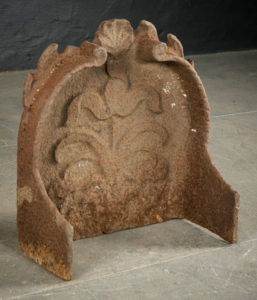
In the April 1915 edition of Volume 41 of The Connoisseur, which described itself as ‘An Illustrated Magazine for Collectors’, a correspondent submitted to its ‘Notes’ section this photograph of an iron fireback that had been found, of all places, in a brook at Poynings in Sussex, a few miles north-west of Brighton. The picture had evidently been cropped from a larger one which had included a pair of fire dogs, parts of which were still visible. The correspondent wanted assistance in identifying the family to which it had originally belonged. A search of the following issues of the magazine failed to reveal an answer to the enquiry.
When I first saw this photograph, as part of a trawl through early publications in search of firebacks, it struck me that it looked like no other back that I had seen. It appeared to have in-turned side edges and the panel on top was unusual with what I guessed were a lion and a unicorn with a crown between them. On the main panel was a tree with a smaller tree apparently growing out of the top of it, and some unreadable text on each side of the tree’s trunk. All rather odd. I contacted the publisher of the village newsletter in Poynings and asked them to insert an appeal for anyone who might still possess this fireback, but I too have had no response.

Then, a while later, a fellow fireback enthusiast in Herefordshire contacted me asking for my opinion of this unusual cast-iron fireback he had acquired. While not the same as the Poynings back, it bears striking similarities to it: the lion, unicorn and crown on top; the curious tree and text below. This time the first part of the inscription can be deciphered; it seems to read ‘SILVESTR…’, a fragment of a Latin word relating to wood or woods, which complements the arboreal design on the main panel. The forward-facing, in-turned sides are much more prominent and they include two opposed piercings, one on each side at a low level, presumably for the insertion of a rod or bar across the front of the fireback. No measurements were given for the Poynings back, but the Herefordshire one is 45.5cm high and 38.5cm wide. The in-turned sides allow it be free-standing and to some extent portable, although it is not of a light weight. This is not surprising given the material it is made from, nor given its presumed purpose, which would have been to form a back against which logs and ash could rest in a more open location than a typical fireplace.


A third example then turned up on the website of a Norfolk antique dealer. Its form is similar – the in-turned sides and tree-related decoration – but no inscription this time, and no lion, unicorn and crown. Instead at the top is a scallop shell, more characteristic of continental firebacks. It is of similar size, at 49cm high by 43cm wide. A fourth example was advertised on the website of a fireback dealer in the Netherlands. At the top, there appears to be a crown between animals (possibly the lion and unicorn again), but this time the main decoration is a humorous bucolic scene of a standing shepherd apparently playing a pipe opposite a seated dog holding the shepherd’s crook. In other respects the form is the same as the first three, and the size, at 52cm high by 46cm wide, a little larger than the other three but comparable nevertheless.
The appearance in the Netherlands of the last of these raises the question as to whether free-standing firebacks are British or continental. The crown between what are more clearly a lion and a unicorn on two of them leads to the conclusion that they are British in origin. So how did one turn up across the Channel? While continental firebacks and copies made from them are common in Britain, British firebacks are not frequently found in French, Belgian, Dutch and German collections, but a few are and in some cases I have encountered they are mistaken for continental designs, especially when British firebacks, at the end of the 17th century, were aping the German backs made for the Dutch market.
As to their date, the lion and unicorn rules out them being from the Tudor period, and they are unlikely to be from the 18th century or after, when coal was increasingly being used for heating and cooking in domestic situations and burnt in iron grates. That leaves us with a likely 17th-century date for this unusual type. They are undoubtedly rare and I shall be most interested to hear of any other examples, and particular situations where they might have been used, that anyone reading this can let me know of.

UPDATE – 5TH JULY 2023: Today I visited Bramshill House, a 17th century ‘prodigy house’ in north Hampshire, which for part of its recent history was a police college. There are 14 firebacks in the building but this one in particular was of special interest because it was another of these free-standing firebacks. Sadly it had been attached to a more recent iron grate but it is very similar to the one illustrated above that had been advertised in the Netherlands, while having the stylised tree motif on the main panel and, this time, what appears to be the ostrich feather badge of the Prince of Wales at the top. Which Prince of Wales? one wonders.